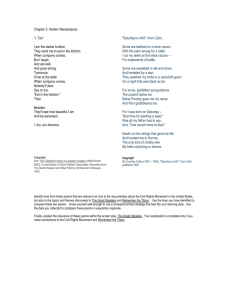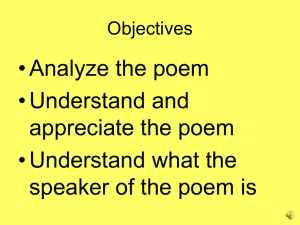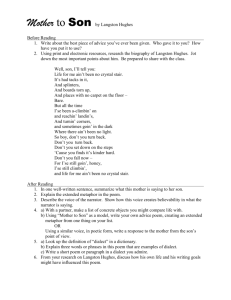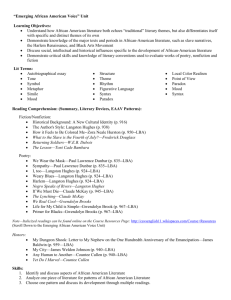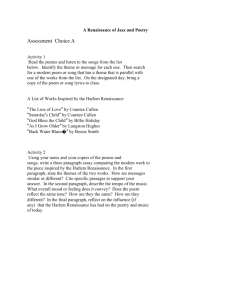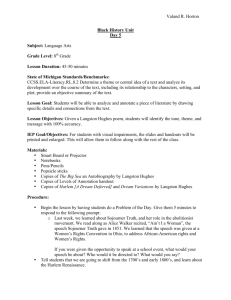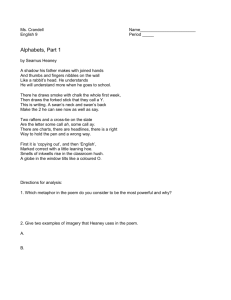AP English Language and Composition
advertisement
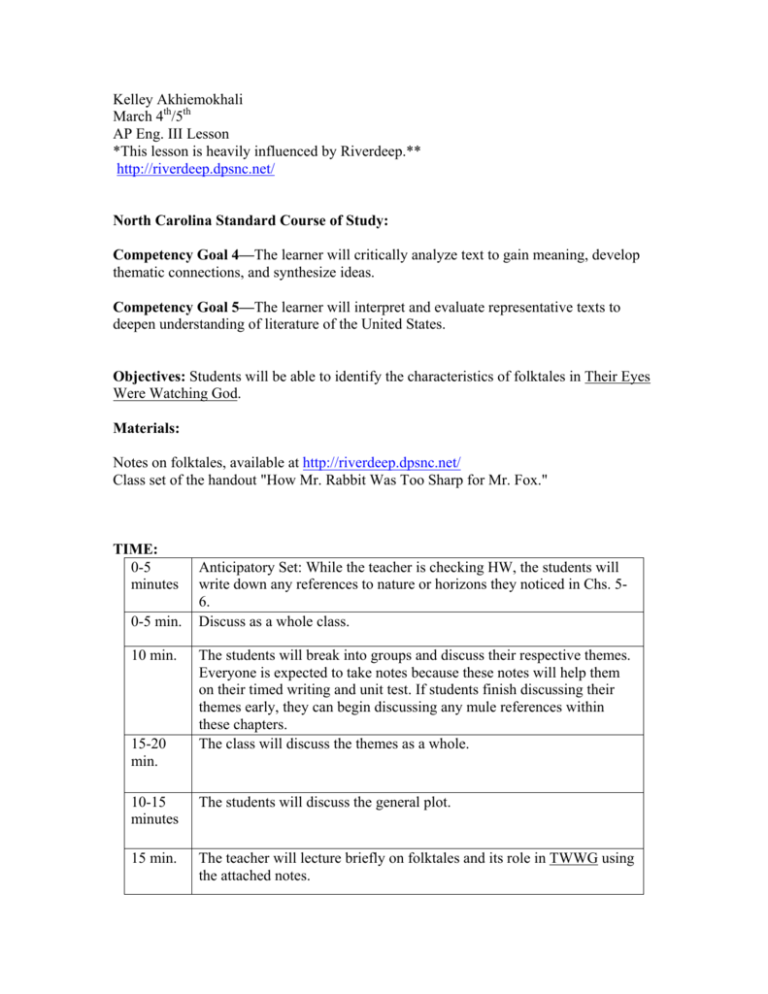
Kelley Akhiemokhali March 4th/5th AP Eng. III Lesson *This lesson is heavily influenced by Riverdeep.** http://riverdeep.dpsnc.net/ North Carolina Standard Course of Study: Competency Goal 4—The learner will critically analyze text to gain meaning, develop thematic connections, and synthesize ideas. Competency Goal 5—The learner will interpret and evaluate representative texts to deepen understanding of literature of the United States. Objectives: Students will be able to identify the characteristics of folktales in Their Eyes Were Watching God. Materials: Notes on folktales, available at http://riverdeep.dpsnc.net/ Class set of the handout "How Mr. Rabbit Was Too Sharp for Mr. Fox." TIME: 0-5 minutes 0-5 min. 10 min. 15-20 min. Anticipatory Set: While the teacher is checking HW, the students will write down any references to nature or horizons they noticed in Chs. 56. Discuss as a whole class. The students will break into groups and discuss their respective themes. Everyone is expected to take notes because these notes will help them on their timed writing and unit test. If students finish discussing their themes early, they can begin discussing any mule references within these chapters. The class will discuss the themes as a whole. 10-15 minutes The students will discuss the general plot. 15 min. The teacher will lecture briefly on folktales and its role in TWWG using the attached notes. 10 min. In small groups, the students will read the folktale “How Mr. Rabbit Was Too Sharp for Mr. Fox.” The dialect will be difficult for most students, which is why they are allowed to work through the material in groups. 10 Discuss what lessons/themes can be taken from this story. How does it reflect back on the community which tells this story? 5 min. 10 min. A: The glorification of the underdog, an ability to outsmart the projected winner, wits over brawn, etc… In the same groups as before, the students can search for folktales in the assigned TWWG chapters. The teacher will briefly discuss how Hurston, as an anthropologist, often incorporated folktales into her work. She definitely incorporated folktales into TWWG. The mule folktale from these chapters is a very important one (and it’s a recurring motif). Kelley Akhiemokhali March 6th/March7th AP Eng. III Lesson *This lesson is heavily influenced by Riverdeep.** http://riverdeep.dpsnc.net/ North Carolina Standard Course of Study: Competency Goal 4—The learner will critically analyze text to gain meaning, develop thematic connections, and synthesize ideas. Competency Goal 5—The learner will interpret and evaluate representative texts to deepen understanding of literature of the United States. Competency Goal 6—The learner will apply conventions of grammar and language usage. Competency Goal 6.01—Demonstrate an understanding of conventions of language by decoding vocabulary using knowledge of Anglo-Saxon, Greek, and Latin bases and affixes. Objectives: Students will be able to discern the meaning of a word by figuring out the meaning of its affixes and suffixes. The students will be able to trace the character development of important characters such as Nanny, Janie, Tea Cake, Logan Killicks, and Joe Starks. Materials: Character Development chart PowerPoint Computer TWWG book TIME: 30 min. The guidance counselors will discuss senior classes and college options with the juniors. 20-25 min. The students will continue with their vocabulary. From the pictures and the words given in the PowerPoint, they should be able to give an estimated guess on what the root word means. The students will break into groups to discuss their assigned themes. The teacher will circulate around the room checking homework. 10 min. 20-30 min. Within the same groups as their theme groups, students will be given a chart to fill in on how a particular character developed (either Janie, Nanny, Logan, Joe, or Tea Cake). The students are expected to also note the motifs of the horizon, nature, and the mule; write down any important quotes; and explain how they believe the character has developed. These charts will be presented during the next class and will help students study for their unit test. Monday, March 10, 2008/ Tuesday, March 11, 2008 Standard Course of Study: Competency Goal 4—The learner will critically analyze text to gain meaning, develop thematic connections, and synthesize ideas. Competency Goal 5—The learner will interpret and evaluate representative texts to deepen understanding of literature of the United States. Competency Goal 6—The learner will apply conventions of grammar and language usage. Competency Goal 6.01—Demonstrate an understanding of conventions of language by decoding vocabulary using knowledge of Anglo-Saxon, Greek, and Latin bases and affixes. Objectives: Students will be able to discern the meaning of a word by figuring out the meaning of its affixes and suffixes. Students will be able to compare and contrast the themes present in Langston Hughes’s “The Negro Speaks of Rivers” to Countee Cullen’s “Heritage.” Students will be able to compare and contrast the themes present in Langston Hughes’s “I, Too” to Walt Whitman’s “I Hear America Singing.” Students will be able to develop an appreciation for Countee Cullen via reading his famous poems “Tableau” and “Incident.” Materials: **The teacher will place an Elements of Literature book underneath every student’s desk before class begins.** Overhead copy of Walt Whitman’s “I Hear America Singing” (also available in The American Reader under The Civil War) Class set of Elements of Literature Textbook Langston Hughes Poetry Packet (students have already received) Copies of Cullen’s “Heritage” Computer Projector Unit 12 Wordskills PowerPoint TIME: 0-5 min. 5-7 min. Anticipatory Set: Walt Whitman’s “I Hear America Singing” will be projected onto the wall as the students walk into the classroom. Students will read the poem and jot down any ideas on how this may relate to the Harlem Renaissance. Why would we be re-reading a poem written in 1860 when talking about a literary movement that happened in 1920s? Transition: Pull out your Langston Hughes poetry packets. We’re going to read his poem “I, Too,” published in 1925. If you do not have the packet either share with someone who does or grab an American Reader. Q: How does this poem compare to “I Hear America Singing?” A: He starts out the poem by saying that he too is singing. Hughes wrote this poem in response to Walt Whitman’s piece. The American Reader states, ‘“It is a response to Walt Whitman’s “I Sing America,” [I Hear America Singing] an affirmation that “the darker brother” also sings an American song and will gain a place at the American table” (Ravitch, 450). 0-2 min. Q: What do you think this says about one of the Harlem Renaissance’s objectives? A: To “speak back” to white literature. Transition: We’re going to continue comparing different poems from the Harlem Renaissance and see if we can tease out more themes and ideas. Being able to synthesize different pieces of literature is great practice for the AP test. “The Negro Speaks of Rivers” is also available in The American Reader under the section World War I and After. The teacher will pass out the Countee Cullen handouts and the attached discussion question: Compare the ideas presented in Cullen’s “Heritage” to those presented in “The Negro Speaks of Rivers.” What claims are made in each respective piece about heritage and its function within society? What can you infer from these pieces about the discussions surrounding the importance, or lack of importance, of heritage within the Harlem Renaissance? 7-10 min. With a partner, take the time to read Hughes’s “The Negro Speaks of Rivers” and then Cullen’s “Heritage” and answer the questions in your notes. 2-5 min. Class discussion about what it means to have a particular cultural history and, perhaps, different notions of Africa. Is Africa often romanticized in certain people’s eyes? What other ideals or countries are used as symbols for a better day or time period? 0-2 min. 5 min. Transition: Let’s now look briefly at two other poems that Cullen is famous for, “Tableau” and “Incident.” There’s SO much literature from the Harlem Renaissance that I want to expose you to, but for the sake of time I can only choose a few pieces. Underneath your desk there should be a textbook. Open it to page 745. We will first read Cullen’s “Tableau.” In “Tableau” there are four metaphors that I want you to look for. We will discuss them briefly after we read the poem (taken from page 748). Ask a student to read “Tableau” aloud. Metaphor—a figure of speech that makes a comparison between two unlike things without the use of a specific word of comparison (745). Q: What are the four metaphors and who or what are they describing? A: The golden splendor of the day—the white boy; the sable pride of night—the black boy; lightning brilliant as a sword—compares lightning to a sword. Essentially describing the shock of the town to see the two boys together; the path of thunder—discussing the future fallout for the two boys transgressing racial mores. 5 min. Transition: We’re now going to read Cullen’s other poem “Incident.” Ask a student to read “Incident” aloud. Questions from pg. 748 2. What do you think leads the “Baltimorean” to act as he does? Are his actions more disturbing or less disturbing because he is a child? Explain. 3. What does the word incident suggest to you? Why do you think Cullen chose this as his title? **This goes back to TP-CASTTing and how a title can change meaning after reading the poem. 4. The speaker never directly states his emotional response to the experience. How does the last stanza indirectly make clear the impact the encounter had on him? 20-30 min. Ms. Baker and the research paper 30-40 min. Transition: We are now going to move into Wordskills. I need everyone to focus and write quickly because we have a lot of important material to cover. We are doubling up on words today because guidance took the majority of the class period last week. Word Skills Vocabulary lesson (see attached PowerPoint created by 12th grade English teacher Anne Olivar). The teacher will teach AGON through PETR. The students will guess what the root word means based on the available picture and the three words given. The students will learn new vocabulary words at the same time. Notes: Hughes wrote “The Negro Speaks of Rivers” while on the train from New England to Mexico to visit his father. This poem, most likely, was inspired by a potential view of the Mississippi River while traveling to Mexico. The poem was published in 1921. Countee Cullen (1903-1946) Born in Kentucky but raised by Elizabeth Porter, who is believed to be his paternal grandmother. After Porter died in 1918, Cullen lived with Rev. Frederick Cullen and Carolyn Cullen in Harlem. Attended NYU Worked on a Master’s at Harvard. Unlike Hughes, did not use the blues or jazz in his own writing. He was a very traditional writer and often followed a strict rhyme scheme. o Similarly, did not use a lot of dialect. Said he was uncomfortable being considered a “race writer,” but some of his most famous poems are about race. How does this compare to Langston Hughes’s intro in The Negro Artist and the Racial Mountain? Received a Guggenheim in 1928. 1928 married W.E.B. Du Bois’s daughter—Nina Yolande Du Bois—left her only two months later and went to Europe. Taught French and English in NYC to support himself Received a lot criticism for trying to bring to the stage Arna Bontemps’ novel God Sends Sunday because, similar to Hughes, it focused on “the lower classes.” Ties to Durham/Fun Facts Hurston worked as a drama instructor at the North Carolina College for Negroes at Durham (North Carolina Central University). Langston Hughes’s poem “Theme for English B” mentions him living in Durham, North Carolina. Assessment: Students will be assessed via class discussion. Kelley Akhiemokhali Educ. 215/Dr. Wynn AP English III Wednesday, March 12, 2008/ Thursday, March 13, 2008 Standard Course of Study: Competency Goal 4—The learner will critically analyze text to gain meaning, develop thematic connections, and synthesize ideas. Competency Goal 5—The learner will interpret and evaluate representative texts to deepen understanding of literature of the United States. Competency Goal 6—The learner will apply conventions of grammar and language usage. Competency Goal 6.01—Demonstrate an understanding of conventions of language by decoding vocabulary using knowledge of Anglo-Saxon, Greek, and Latin bases and affixes. Objectives: Students will be able to write an essay explaining how the theme of either love/money/happiness; race; women’s empowerment; or independence influences Their Eyes Were Watching God. Students will be able to discern the meaning of a word by figuring out the meaning of its affixes and suffixes. Materials: Copies of the essay prompt Computer Projector WordSkills 12 Synthesis Packets Directions on which poems and essays to omit TIME: 0-5 min. Welcome to class. Today there is a timed writing so please clear your desk of everything except your book, your notes on the various themes, a pen, and paper. You are allowed to write on this prompt. The teacher will pass out the prompt. 45 min. The students will have 45 min. to write an essay that answers one of the following questions: 1.) How does Janie become more independent as the novel progresses? Identify at least three major steps she takes toward becoming a more empowered woman in the book. 2.) Which do you think is more essential to finding happiness, love or money? Qualify your answer using examples from Janie’s life. 3.) Identify 2-4 key points in the novel in which race influences the direction of the plot. How does race play a role in the novel as a whole? 20-30 min. **These questions were prepared by Lauren Kolbyarz for her Harlem Renaissance unit.** Transition: We are now going to move into Wordskills. I need everyone to focus and write quickly because we have a lot of important material to cover. We are doubling up on words today because guidance took the majority of the class period last week. Word Skills Vocabulary lesson (see attached PowerPoint created by 12th grade English teacher Anne Olivar). The teacher will teach PLE (PLEN, PLET) through VICT (VINC). The students will guess what the root word means based on the available picture and the three words given. The students will learn new vocabulary words at the same time. 25 min. Transition: If you’re done copying down the vocabulary words pull out the various copies of literature we have read so far with the Harlem Renaissance. With a partner, students will begin to fill out the synthesis chart (attached). This chart will help the students review for their test, which will be Thursday, March 20th or Monday, March 24th. The teacher will also hand out instructions on which pieces to omit. In order to save paper, the teacher did not recopy the new synthesis chart since everything was already printed. The students will have time during the next class period to continue working on the synthesis chart. The teacher can play soft jazz or blues music in the background while the students work. The teacher will circulate around the room to make sure the students are remaining on task. The teacher will check the students’ HW while they are working on the synthesis packets. Assessment: The students will be assessed via their essays and the discussions they have in groups. Kelley Akhiemokhali Educ. 215/Dr. Wynn AP English III Friday, March 14, 2008/ Monday, March 17, 2008 Standard Course of Study: Competency Goal 4—The learner will critically analyze text to gain meaning, develop thematic connections, and synthesize ideas. Competency Goal 5—The learner will interpret and evaluate representative texts to deepen understanding of literature of the United States. Competency Goal 6.01—Demonstrate an understanding of conventions of language by decoding vocabulary using knowledge of Anglo-Saxon, Greek, and Latin bases and affixes. Objectives: Students will be able to discern the meaning of a word by figuring out the meaning of its affixes and suffixes. Students will be able to discuss how plot development, certain quotes, passages, and phrases impact four of Their Eyes Were Watching God’s themes (love/money/happiness, independence, women’s empowerment, and race). Students will be able to synthesize the various literature and themes they have read in order to draw parallels amongst different texts and Their Eyes Were Watching God. Materials: Index Cards Computer Projector Copies of TWWG Review Sheet REMINDERS: Drafts of paper are due March 18th or 19th. Begin reviewing for test. Know how to TP-CASTT a poem. Review all of the material we have covered in class. Continue studying for the test (20th or the 24th). Ms. Akhiemokhali will stop teaching on March 20th or the 24th (test day). Ms. Baker will teach the next class period (18th and 19th). Ms. Akhiemokhali will remain at Jordan until April 11th. TIME: 10-15 minutes 10-15 minutes The students will break into their jigsaw groups and discuss the themes of love/money/happiness, race, women’s empowerment, and independence. As the students are talking amongst themselves, the teacher will go around and check HW. If the students finish early, they can work on their synthesis packets. As a whole, the students will discuss the final chapters of TWWG. Students will stay in their groups, but turn so that they can face the teacher. The following discussion questions, from Riverdeep, can serve as a conversation starter: 1. State and explain Tea Cake’s reaction to the approaching hurricane. 2. Explain the significance of the phrase “their eyes were watching God.” 3. Detail Janie and Tea Cake’s encounter with the mad dog during the hurricane. Chapters 19-20 4. Tea Cake and Janie find safety in Palm Beach. Describe Tea Cake’s encounter with two white men in town. 5. Tea Cake brings Janie surprising news about one of their friends after the hurricane. Summarize Tea Cake’s news. 6. Describe Tea Cake’s illness. 7. Detail the circumstances surrounding Tea Cake’s death. 8. Why does Janie leave the muck? 9. Why is Janie now able to live in her old house? By default, when discussing the plot the four themes will also be discussed. 20-30 min. TWWG Figurative Language Search (10 min. to write and 10 min. to share) Transition: We have now discussed the overall plot and themes present in TWWG. Of course, I’m going to ask everyone to dig deeper still. One of the reasons Hurston’s book is so famous is because of its figurative language. What are some examples of figurative language? We are going to look at personification, hyperboles, metaphors, and similes. Personification--giving human-like qualities to inanimate objects. Metaphors— implied comparison of seemingly unlike objects not using “like” or “as” Similes-- comparison of seemingly unlike objects using “like” or “as” Hyperboles--an exaggeration The teacher will hand each child a color-coded index card. Green= personification, yellow= hyperboles, orange= metaphors and green = similes. Each group will have the same color-coded card. Each student should write their name on the card. On one side of the card the student should write the definition of their term. On the other side they should write one or two examples of their term from the text. This will be taken up by the teacher. Ex: Kelley Akhiemokhali Personification—giving human-like qualities to inanimate objects. “The sea was walking the earth with a heavy heel.” “The sun left his footprints in the sky.” Each group will share two examples that they found from the text. 15-20 min. 0-5 min. (This activity is based off of the AP Vertical Teams Guide for English and a recommendation by Lauren Kolbyarz) Synthesis Chart Activity Either within their group or by themselves, students will be given time to work on their synthesis chart. The teacher will circulate around the room and answer any questions the students may have concerning the texts. Transition: We have covered a lot in the past few weeks. We’ve looked at authors from Langston Hughes to Marita Bonner. We’ve TP-CASTTed poems and talked about some of the social issues that surrounded the Harlem Renaissance. TWWG had us look at a certain dialect and, sometimes, new words. Before we move on to vocabulary—some more new words—I want to close the literature unit by doing two things: 1.) reading a poem that I love and 2.) asking for the class’s opinion. I first read Langston Hughes’s “Mother to Son” poem when my grandmother gave me a book of AfricanAmerican literature when I was in the second grade. [I will read the poem]. On a scrap sheet of paper, you do not have to write your name on it, please write down two things that you liked and/or learned about this unit and two things you think could have been done differently. Once I collect those, pull out your Word Skills books. 20-30 min. Word Skills Vocabulary Students will continue with Word Skills. The goal is to work through as many words as is feasibly possible while still making sure that learning is taking place. The guidance counselor’s visit last week eliminated vocabulary and, as a result, placed the classes behind schedule. Assessment: Students will be assessed via the index card activity, group discussion, and class discussion.

